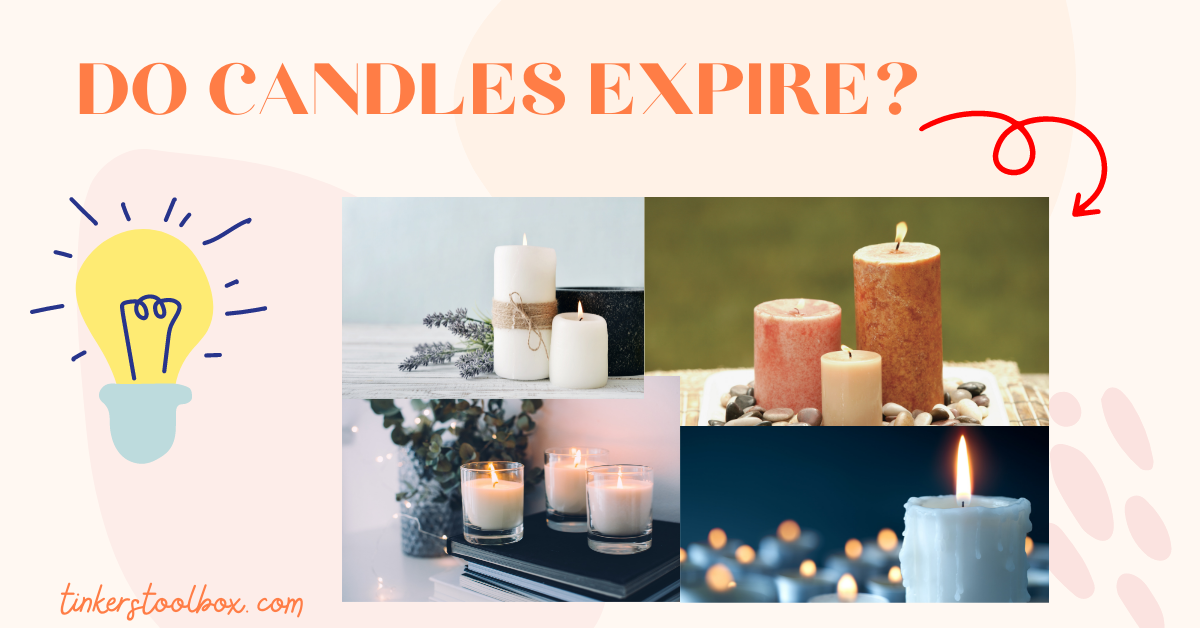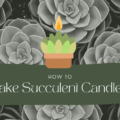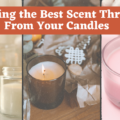Often, candles that we bought would pile up in our storage, lit just a little or not lit at all. Our love for candles made us buy many of them without even being able to consume them. You might be wondering if they are still good to use after some time or better off as trash, which is a great waste of money. Let me clear up all these confusions and give you the answers you need.
Candles may expire and spoil in a way that they decrease or completely lose their original scent, undergo color fading or discoloration process, or sometimes rot for organic waxes. You may also notice some physical changes in the candle’s flame, smell, and appearance once it starts to go bad.
This article will talk about how candles degrade over time and why they do expire like any other products you buy in the market. We will also dig into all the signs you need to observe to know when the candle has completely gone bad and would not be of use anymore. Lastly, I’ll provide you with some tips to make your candle last longer and still well-burning even after a long time of use.
Candles Do Expire and Degrade Over Time: A Must-Remember
Candles expire and degrade over time, but it is not the same how food spoils. It’s more like the aging caused many factors that make the candles go bad, therefore unusable. Regardless of the candle wax used, scents, and colors incorporated, candles have a specific life span and would have poor performance over time.
How Long Do Candles Last: The Timeline You Need to Know
When you light a candle, the amount of time it burns is called burn time. Burn time depends on the candle’s size, wax type, and the wicks used. If candles are burned regularly, they will be consumed a day to a week, with no worries of expiring. Generally, beeswax would burn for up to 29 hours, soy wax for 18 hours, and paraffin lasts up to 15 hours of burning.
But, it’s a different story when your candles are unlit and not stored properly. The life span of unlit candles is greatly affected by the type of wax used and how well the candles are stored. Some waxes have longer life spans, like paraffin and beeswax.
Natural waxes like soy and palm wax would not last as long since natural ingredients decay over time. Candles made from natural wax are best used within one to two years but would show some signs of degradation at the 12-18 month mark. A general rule of thumb is to consume the candle within a year of purchase to get the best performance.
Candle Types and Their Expected Life Span: Be Guided in Using Your Candles
Soy candles are natural candles made from organic ingredients. They may begin to deteriorate after about a year to a year and a half if not consumed at all. If stored properly, the most you can get with soy wax would be two years.
Beeswax candles have the most preserved wax and the longest shelf life. You can store it for a long time, with little to no degradation if stored well. Beeswax is considered to have no expiration date, as ancient Egyptians used it for the mummification process in the olden times.
Paraffin candles are considered to have a long shelf life of at least five years. The maximum number would be indefinite as paraffin is a very versatile wax, easily adapts to temperature changes, and holds additives very well.
Palm wax is another organic wax that may rot over time. However, it lasts longer than soy wax, as this hard wax has a higher melting point than soy wax or paraffin wax. This means that palm wax candles are more thermally stable and burn slower than other candles.
Palm wax’s molecular structure also allows it to hold more fragrances, retain it into the candle, and slowly release it to the air. This type of wax may perform better than soy wax, but it is still organic, which could rot over time and cause candle spoilage.
Knowing When Your Candles Have Expired: The Signs and Indications
There are subtle signs you may notice once your candle has begun expiring. Note that you may still burn these candles, but they will have poor burning performance as they age over time. Here are some of the indicators you’ll notice on degrading candles.
Candle Scents Would Weaken: It Would Not Be the Same as Before
The first sign of degradation in candles is a weakened scent. A candle gives off a different scent when unlit (cold throw) and burning (hot throw). When an unlit candle stays stored for too long, it gradually loses its fragrance as the fragrance oil’s molecules slowly evaporate from the wax into the air even without lighting the candle.
Scent degradation happens very gradually. It is almost unnoticeable upon the first six months to a year of your candle purchase. Furthermore, it would also depend on the type of wax used in the candles, as some waxes can hold fragrances evaporate well, one of which is paraffin.
However, scent degradation continuously happens from the moment you buy your candles, so if you keep them unlit and stored for a long time, they will eventually lose their scent and have a weak hot throw when you burn them.
Candle scents are either from fragrance oils, chemically produced for candles, essential oils sourced from natural ingredients or a combination of the two. When compared, essential oils would decay and cause candles to expire faster than fragrance oils’ effect.
If your candle had a very strong scent to start with, the aroma might linger on the candle longer. Over time it will smell fainter and fainter until it will not smell at all because all of the scents have already dissipated into the air.
On the other hand, if a foul smell is produced when lighting the candle, there is no denying that the candle has gone bad and exceeded its shelf life. Hence, manufacturers recommend that scented candles be used within a year of purchase.
Candle Colors Would Fade: An Obvious Sign of Degradation
Color fading and deterioration is another sign that your candle started going bad. This is often recognizable in colored candles, where manufacturers use color dyes to give your ordinary white candles life.
Exposure to UV light, whether from direct exposure to the sun or indoor lights, is the number one reason for color fading on candles. The dyes mixed into the candle wax tend to oxidize and degrade, resulting in faded colors.
How long your candle color lasts would be hard to predict as it depends on the type of color dyes used and the ability of the candle wax to hold additives. Some manufacturers also incorporate UV protectant additives into the wax to slow down discoloration and color fading.
Candle color fading is easier to manage and control than losing the candle scent. Just place your candles away from direct exposure to UV lights, and they may retain their colors for a long time.
Physical Changes on the Candle: Signs that A Candle is Aging
Vegetable-based waxes, which are organic like soy and palm wax, are more prone to degradation. You may notice this when their candlewick becomes clogged, making it difficult for you to light and burn them properly.
Aside from color fading, candles would sometimes change from their original color to yellow, green, or brown, indicating expiration.
Observe your candle’s flame. If it is incredibly small, sputtering, flickering, and keeps going out, then the candle is in bad shape and would give you poor burn performance. You may also notice that the flame looks dim and dull as the candlewick may be clogged and not in good shape. This means it’s better off not to be used anymore.
Another thing to note to tell if the candle is expired is if it looks dried out and not its usual velvety look and feel. You may also notice a somewhat rotten look to the candle if it is made from vegetable-based waxes and infused with essential oils, both from organic sources, which naturally decay.
Remember that wick and flame problems indicate that the candles are gone for good. But, if it’s just the visuals, colors, and aroma fading, if it can still burn well, then it’s still good for use and can still light up a room.
Tips to Make Your Candle Last Longer: Your Guide to Long Lasting Candles
Here are some tips and tricks to make candles last longer and slow down their inevitable aging process.
Store Candles in a Dark Place: Away from All Light Sources
UV light would not only fade candle colors but can also break down fragrances. You want to keep your candles away from any UV light sources and store them in a dark place where no light comes in.
This method will slow down the candle’s discoloration, and color fading as UV light is the culprit to candle color break down.
Keep Candles in a Cool and Dry Place: The Proper Candle Storage
Candles should not be exposed in places where there are constant temperature fluctuations, especially in extreme heat. When you store them in a hot place, the candle’s chemistry may be altered, speeding up the expiration process. Just the same, when placed in a cool area like a refrigerator, the candle may shrink, crack, and not burn properly.
The correct temperature to maintain for candles is room temperature. The presence of moisture may dampen or wet the wick, causing the candle not to light up at all. You can store them in a closet, away from any moisture.
A candle wax with excessive color dyes and fragrances is less thermally stable. In return, the candle experiences oxidation, a chemical reaction in the candle, making it sensitive to temperature fluctuations. Some manufacturers put anti-oxidants in candles to make them more stable when exposed to temperature fluctuations.
Use a Candle Lid or Topper: Preserve the Candle Fragrance
This tip applies greatly to scented candles. Most of the time, scented candles come in a container and a lid, meant to be used for storing purposes. This prevents air from interfering with the candle and the fragrances from escaping the candle.
You can also use zip-up bags or plastic tubs to store candles that don’t have their container and lid. These containers also prevent direct exposure to light, moisture, and dust particles, greatly contributing to speeding the aging process.
Pillars and tapers, often used for display purposes, often lose their fragrance faster than container candles, which you can store properly.
Use UV Absorbers: Protect Candles from UV Light
UV absorbers can be incorporated in candles to reduce the chemical reaction of UV light to candles, which makes the colors fade. The substance works by collecting the UV radiation and releasing the energy as heat to prevent the candle from discoloring.
Note that no matter how many additives and UV protectors you put in candles, they cannot be fully protected from UV radiation. The candle discoloring naturally happens over time, and we can only lessen it and not completely prevent it from happening.
Candle Care Tips: Prolong Candle Shelf Life
Proper storage is not the only thing you can do to prolong your candle’s shelf life. You should also practice candle care to maximize its burn time and for the candle to perform well even after being stored for a long time.
Keep candles away from drafts and vents when lit. This ensures that the candle would burn evenly, and the flame would be steady and not easily blown out. If you burn candles evenly, they will have a longer burn time as there would be enough wax for the flame to burn. Whereas if they are exposed to drafts, one side of the candle would have more melted wax than the other, causing an uneven burn and less burn time.
Suppose you’ll be lighting a candle stored for a long time or just your favorite candle that you regularly burn. Trim the candle wick, about a quarter-inch long, before each burn to ensure an even burn throughout the sides of the candle and avoid producing smoke, which would discolor the candle.
Another tip to ensure a well-burning candle is the proper first burn. Make sure that the top layer of the candle melts completely before extinguishing the flame. This helps create the wax’s memory and prevents tunneling in the succeeding burns of your candle.
Conclusion
No matter what additives we put into preserving candles, their aging process is inevitable, especially if you use organic ingredients for your candles, like vegetable-based waxes and essential oils. As other products go, candles would also reach a point where they would expire and no longer be used. Proper storage and care for your candles are great ways to prolong their shelf life.















